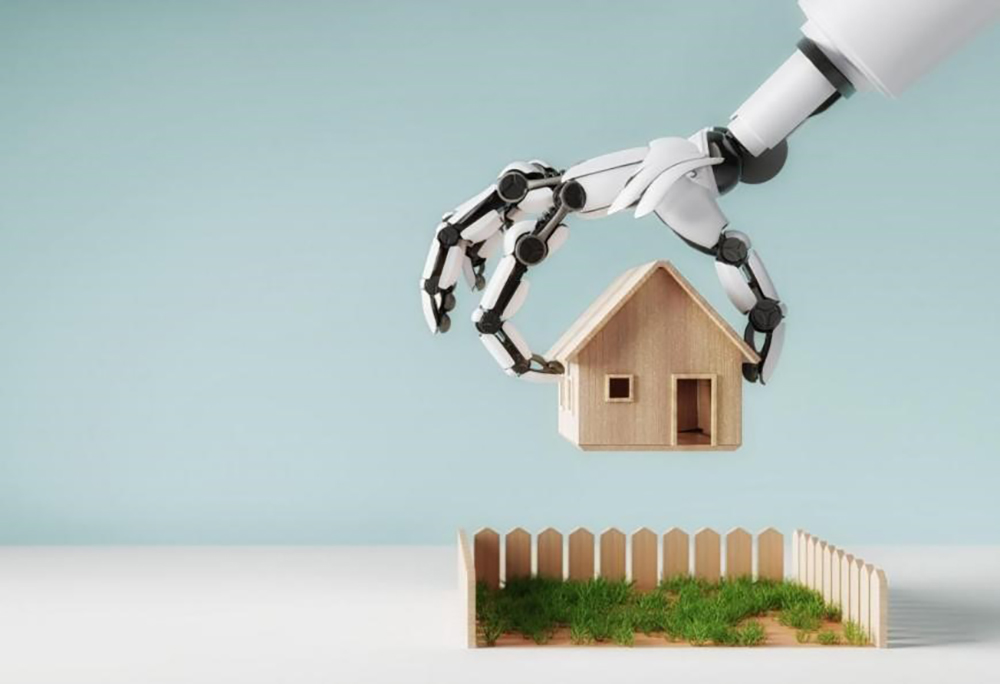
當洛根·法雷爾將一個Rugged機器人放到一個商業地產項目的地上時,這個機器人立即知道了自己應該做什么——繪制這個建筑物的布局。
該機器人參考了3D計算機建模和工程設計學,用來測繪各種線路、立柱和管道的位置。這個工作以往需要建筑設計師、管道工、結構工程師和電工等工種用卷尺、粉筆等工具進行大量測繪和圖上作業。但是Rugged機器人卻能夠精確地獨自完成這一系列工作,全程不需要與人類進行互動。
“它是非常智能的,它可以解讀計算機輔助的設計數據,并且將其帶入到現實世界中。”法雷爾說。法雷爾與德里克·莫爾斯共同創辦了Rugged Robots公司,他也是該公司的首席技術官。
除了Rugged Robots之外,還有不少科技公司也已經開始把人工智能技術應用到建筑領域。法雷爾表示,現在業界的不少同類公司都在研究如何用人工智能技術解決建模階段和早期施工階段的技術難點,而這還只是建筑行業技術創新的一個開端。
像Rugged Robots和Dusty Robotics這樣的公司,則主要使用機器人對建筑工地進行測繪,其優勢是可以提高效能和限制誤差。他們的機器人能夠在工地現場“打印”出工程布局,這樣工人就知道應該在哪里施工、哪里不能施工了。像BotBuilt和Canvas等公司也把機器人應用到了建筑施工過程中,他們的機器人主要應用于精確測繪、使用替代建材以及安全石膏板預制件等較為耗費人力的工作。
很多這一類公司的創辦初衷,是為了利用機器人技術來輔助人類勞動,以解決建筑業面臨的工人短缺問題。現在大量經驗豐富的工人都將從建筑業的各個領域退休,可以接替他們的新一代技術工人越來越少。Rugged Robots公司的首席執行官德里克·莫爾斯指出,這些老工人的退休,不僅僅給工地留下了一堆技術問題,還帶走了很多寶貴的知識。結果老板們經常需要花費更長的時間才能完成同樣的任務。
“現在我們每引進一個客戶,就會有兩個工人退休。所以我們迫切需要快速培養新工人的技能。”Canvas公司的創始人及首席執行官凱文·阿爾伯特表示。這家公司是一家專門給建筑工地安裝墻壁的機器人公司。
阿爾伯特介紹道,Canvas公司的機器人能夠承擔安裝預制板這種極耗人力的工作。確定安裝計劃和建材之后,這款機器人就可以利用各種測繪傳感器和機械臂自行安裝預制板。而且經過訓練后,它也會學會了使用各種必要的手動工具。
阿爾伯特表示,機器人的準確性能夠減少傳統施工中的步驟,加快工作進度。因此原本需要人工五天完成的工作,Canvas機器人只需要兩天就能完成。
在機器人安裝預制板的同時,人類勞動也過渡到了更高技能的任務,例如監督機器人工作、管理團隊、調整施工進度、確保安全施工等等。它還給人類創造了一些新的機會,比如在機器人的輔助下,現在殘疾人也可以從事建筑行業的工作了,否則以前他們是根本無法完成某些施工任務的。
“我們看到,它促進了公平就業。”阿爾伯特說。
這些公司的創始人也很重視建筑業的文化,他們把自己定位為建筑業的合作伙伴,而不是要取代誰。例如BotBuilt的聯合創始人及首席執行官布倫特·瓦達斯就花了好幾年的時間,深入了解建筑業的生態,看機器人怎樣才能在關鍵建材的制造領域派上用場。他的機器人主要負責住宅框架的建造工作,原來在不使用科技手段的情況下,一套房子的框架一般需要四周到五周的時間才能搭建完成。但現在使用機器人的話,則只需要兩個小時到五個小時。
瓦達斯表示,他希望找到一種降低住宅價格的方法,以減輕壓在美國普通老百姓身上的房價壓力。其中的一個重要方法就是壓低建筑成本,通過加快施工速度,提高施工精確度,使小型開發商和定制房屋制造商無需向消費者轉嫁過高的成本。另外施工進度提高后,他們在相同時間里還能夠建造更多的房子。
瓦達斯介紹道,為了實現這一目標,他的公司正在開發一種以往使用得較少,但卻更加環保的木料——壁骨木,這種木料可以被他的機器人直接用于房屋框架的搭建過程。他表示,這種木料比進口的蘇格蘭松木和其他住宅常用木材便宜40%到60%。以前這種木料經常會被丟棄,因為它有時會存在缺陷,一般大型工廠使用的傳統生產線是不難容易發現這些缺陷的。但對高科技機器人來說,它能夠通過編程和計算機視覺來發現這些缺陷,從而將這些木料應用到房屋框架的搭建。
與其他機器人公司的高管一樣,瓦達斯也只是將人工智能技術驅動的機器人視為建筑施工隊用得著的一個必要設備,與挖掘機、叉車或者起重機沒有什么區別——它們都是需要人類操作的機器。
“我們的目標就是創造一種可以讓人在更安全、更可控的空間里輕松操縱的‘電動工具’。”瓦達斯說。他還表示,他曾經在一些社區大學和職業學院里為機電專業的學生講過機器人和創業相關的課程。“希望我們能夠通過教育,讓下一代意識到,木工和建筑行業也是有很大的樂趣的。”
“而且我認為,這對招募新人也有很大的幫助。你可以跟人說:‘我是玩機器人的,你是做什么的?’”(財富中文網)
譯者:樸成奎
當洛根·法雷爾將一個Rugged機器人放到一個商業地產項目的地上時,這個機器人立即知道了自己應該做什么——繪制這個建筑物的布局。
該機器人參考了3D計算機建模和工程設計學,用來測繪各種線路、立柱和管道的位置。這個工作以往需要建筑設計師、管道工、結構工程師和電工等工種用卷尺、粉筆等工具進行大量測繪和圖上作業。但是Rugged機器人卻能夠精確地獨自完成這一系列工作,全程不需要與人類進行互動。
“它是非常智能的,它可以解讀計算機輔助的設計數據,并且將其帶入到現實世界中。”法雷爾說。法雷爾與德里克·莫爾斯共同創辦了Rugged Robots公司,他也是該公司的首席技術官。
除了Rugged Robots之外,還有不少科技公司也已經開始把人工智能技術應用到建筑領域。法雷爾表示,現在業界的不少同類公司都在研究如何用人工智能技術解決建模階段和早期施工階段的技術難點,而這還只是建筑行業技術創新的一個開端。
像Rugged Robots和Dusty Robotics這樣的公司,則主要使用機器人對建筑工地進行測繪,其優勢是可以提高效能和限制誤差。他們的機器人能夠在工地現場“打印”出工程布局,這樣工人就知道應該在哪里施工、哪里不能施工了。像BotBuilt和Canvas等公司也把機器人應用到了建筑施工過程中,他們的機器人主要應用于精確測繪、使用替代建材以及安全石膏板預制件等較為耗費人力的工作。
很多這一類公司的創辦初衷,是為了利用機器人技術來輔助人類勞動,以解決建筑業面臨的工人短缺問題。現在大量經驗豐富的工人都將從建筑業的各個領域退休,可以接替他們的新一代技術工人越來越少。Rugged Robots公司的首席執行官德里克·莫爾斯指出,這些老工人的退休,不僅僅給工地留下了一堆技術問題,還帶走了很多寶貴的知識。結果老板們經常需要花費更長的時間才能完成同樣的任務。
“現在我們每引進一個客戶,就會有兩個工人退休。所以我們迫切需要快速培養新工人的技能。”Canvas公司的創始人及首席執行官凱文·阿爾伯特表示。這家公司是一家專門給建筑工地安裝墻壁的機器人公司。
阿爾伯特介紹道,Canvas公司的機器人能夠承擔安裝預制板這種極耗人力的工作。確定安裝計劃和建材之后,這款機器人就可以利用各種測繪傳感器和機械臂自行安裝預制板。而且經過訓練后,它也會學會了使用各種必要的手動工具。
阿爾伯特表示,機器人的準確性能夠減少傳統施工中的步驟,加快工作進度。因此原本需要人工五天完成的工作,Canvas機器人只需要兩天就能完成。
在機器人安裝預制板的同時,人類勞動也過渡到了更高技能的任務,例如監督機器人工作、管理團隊、調整施工進度、確保安全施工等等。它還給人類創造了一些新的機會,比如在機器人的輔助下,現在殘疾人也可以從事建筑行業的工作了,否則以前他們是根本無法完成某些施工任務的。
“我們看到,它促進了公平就業。”阿爾伯特說。
這些公司的創始人也很重視建筑業的文化,他們把自己定位為建筑業的合作伙伴,而不是要取代誰。例如BotBuilt的聯合創始人及首席執行官布倫特·瓦達斯就花了好幾年的時間,深入了解建筑業的生態,看機器人怎樣才能在關鍵建材的制造領域派上用場。他的機器人主要負責住宅框架的建造工作,原來在不使用科技手段的情況下,一套房子的框架一般需要四周到五周的時間才能搭建完成。但現在使用機器人的話,則只需要兩個小時到五個小時。
瓦達斯表示,他希望找到一種降低住宅價格的方法,以減輕壓在美國普通老百姓身上的房價壓力。其中的一個重要方法就是壓低建筑成本,通過加快施工速度,提高施工精確度,使小型開發商和定制房屋制造商無需向消費者轉嫁過高的成本。另外施工進度提高后,他們在相同時間里還能夠建造更多的房子。
瓦達斯介紹道,為了實現這一目標,他的公司正在開發一種以往使用得較少,但卻更加環保的木料——壁骨木,這種木料可以被他的機器人直接用于房屋框架的搭建過程。他表示,這種木料比進口的蘇格蘭松木和其他住宅常用木材便宜40%到60%。以前這種木料經常會被丟棄,因為它有時會存在缺陷,一般大型工廠使用的傳統生產線是不難容易發現這些缺陷的。但對高科技機器人來說,它能夠通過編程和計算機視覺來發現這些缺陷,從而將這些木料應用到房屋框架的搭建。
與其他機器人公司的高管一樣,瓦達斯也只是將人工智能技術驅動的機器人視為建筑施工隊用得著的一個必要設備,與挖掘機、叉車或者起重機沒有什么區別——它們都是需要人類操作的機器。
“我們的目標就是創造一種可以讓人在更安全、更可控的空間里輕松操縱的‘電動工具’。”瓦達斯說。他還表示,他曾經在一些社區大學和職業學院里為機電專業的學生講過機器人和創業相關的課程。“希望我們能夠通過教育,讓下一代意識到,木工和建筑行業也是有很大的樂趣的。”
“而且我認為,這對招募新人也有很大的幫助。你可以跟人說:‘我是玩機器人的,你是做什么的?’”(財富中文網)
譯者:樸成奎
When Logan Farrell places one of his Rugged Robots on the floor of a commercial construction project, it knows exactly what to do: draw the layout of the building.
The robot references 3D computer architectural and engineering designs to place details like lines, columns, and the diameter of water pipes throughout the construction zone. This task was traditionally done with a set of plans, tape measure, and chalk line by various trades, including architects, plumbers, structural engineers, and electricians. With a Rugged Robot, that’s all marked up with precision—and no human interaction.
“It is ‘intelligent’ in the sense it can interpret computer-assisted design data and bring it into the real world,” says Farrell, who founded Rugged Robots with Derrick Morse and also serves as the company’s chief technology officer.
Rugged Robots is just one of the technology companies leveraging emerging artificial intelligence technologies to solve construction challenges in the built world. Farrell explains that many of his peers are looking at modeling-stage and early construction pain points, and it’s just the beginning for innovation in the construction industry.
Companies like Rugged and Dusty Robotics are tackling this stage by using robots to help draw life-size building model layout plans at construction sites to improve efficiency and limit errors. They have developed robots that print building layouts on the floor of construction sites, so workers know where—and where not—to build. Similarly, companies including BotBuilt and Canvas are using robots to help with the actual building process, by measuring more precisely, making use of alternative materials, and installing laborious components like drywall.
The motivation for many of these founders is to use technology to assist human labor in the process. A lot of it has to do with the labor shortage in construction; experienced workers are retiring out of various construction-focused industries, and there are less new skilled workers taking their places. Morse, Rugged’s chief executive officer, says he saw the workforce not only leaving the ability to complete the task, but taking valuable knowledge with them. The greener employers often took longer to complete the same task.
“Right now, we’re retiring two people for every one customer we bring in, so we have a huge need to bring new workers up on skills quickly,” says Kevin Albert, founder and chief executive officer of Canvas, a robotics company that installs walls at construction sites.
Canvas robots, Albert explains, take over a labor-intensive trade, drywall installation, and put the human power in programming a robot. The robot, equipped with the plans and materials, then plots its own course to install drywall using a suite of sensors for mapping and a robotic arm for material application. It’s trained to use all the necessary hand tools too.
Albert says that the accuracy of the machine reduces the number of steps in the traditional process and can speed up work. What may take human labor five days to complete will take Canvas robots about two days to do.
While the machine is installing the drywall, the human labor has transitioned to higher skill tasks, overseeing the robots but also managing teams, adjusting the scheduling, moving forward to the next step of the construction process, and ensuring safety protocols. Albert notes that it also creates opportunities for people, such as those with disabilities, to be involved in the construction trade who may not otherwise be physically able to do some of the building tasks.
“We’ve seen it level the playing field,” Albert says.
These founders are also keeping construction culture in mind; instead of coming in as a replacement, they position themselves as partners. Brent Wadas, cofounder and chief executive officer of BotBuilt, spent years getting to know builders to understand how robots could help with the manufacturing process for critical building materials. His company builds residential home frames using robots, a time frame that typically takes four to five weeks without the assistance of technology. With robots, it’s done in two to five hours.
Wadas says that he wanted to find a way to decrease residential home prices, referencing the housing affordability crisis in the U.S. One big way to do that is to lower the cost of construction. By speeding up the process, and with more precision, the small-scale developers and custom home builders don’t have to pass along as high of a cost to the consumer. They can also complete homes more quickly, allowing them to build more in the same amount of time.
For Wadas, that included identifying and developing a lesser-used but more sustainable type of lumber, stud wood, that his robots could use in the framing process. It costs 40% to 60% less than imported Scottish pine and other commonly used lumber for residential homes, he says. Previously, it was often discarded because it sometimes has imperfections that are tough to catch in traditional manufacturing lines as a part of massive factories. But with high-touch robots, which can be programmed to notice inconsistencies with a computer vision system, the stud wood is easily adapted for framing.
Wadas, like other robotics company executives, views A.I.-driven machines as essential equipment for construction teams, as you would an excavator, a forklift, or a crane—all machines operated by a human.
“Our goal is to create a ‘power tool’ that can be operated by a human at an easy pace in a safer, controlled space,” Wadas says, noting that he has lectured at community colleges and vocational schools on robotics and entrepreneurship to mechatronics students. “Hopefully, we are educating the next generation that there can be great joy in carpentry and construction.”
“I think it will do great things for recruiting numbers,” he adds: “By the way, I play with robots. What do you do?”






